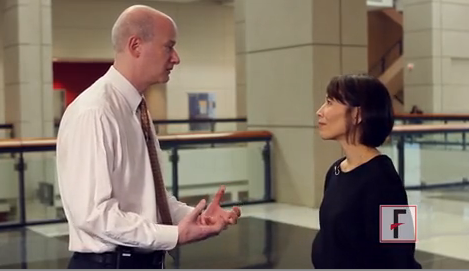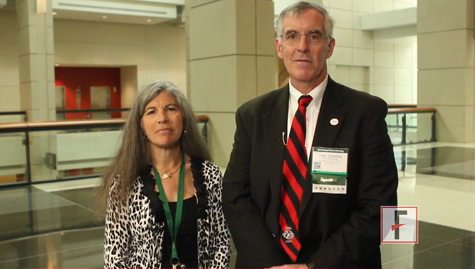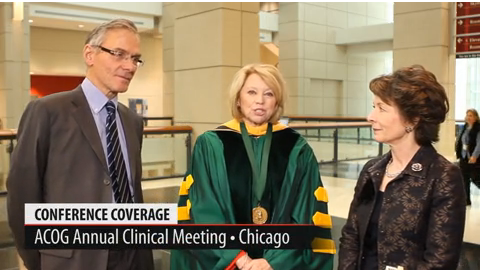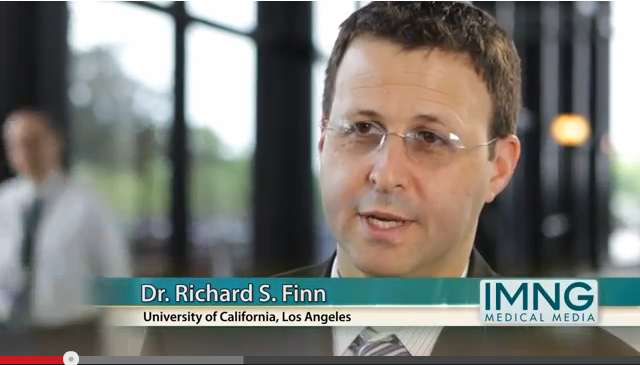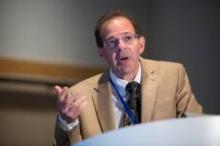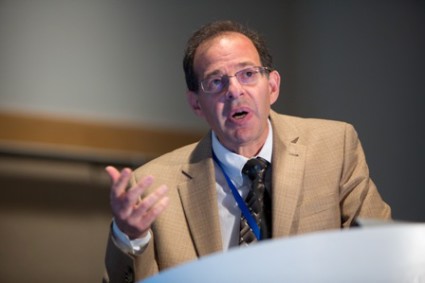User login
VIDEO: HPV testing predicted to displace most Pap smears
CHICAGO – Dr. Laurie J. McKenzie, who is a member of the ACOG Committee on the Scientific Program and the medical faculties of the University of Texas and Baylor College of Medicine, Houston, interviews Dr. Michael M. Frumovitz of the University of Texas MD Anderson Cancer Center, Houston, the presenter of the John I. Brewer Memorial Lecture on cervical cancer screening.
During a video interview at the annual meeting of the American Congress of Obstetricians and Gynecologists, they discuss reductions in cervical dysplasia that have already been seen with HPV vaccination in Australia and note the barriers to HPV vaccination in the United States. Dr. Frumovitz predicts that HPV testing will ultimately replace Pap smears for primary screening in most cases and discusses the potential for high-resolution microendoscopy to change how cervical lesions are diagnosed and treated.
CHICAGO – Dr. Laurie J. McKenzie, who is a member of the ACOG Committee on the Scientific Program and the medical faculties of the University of Texas and Baylor College of Medicine, Houston, interviews Dr. Michael M. Frumovitz of the University of Texas MD Anderson Cancer Center, Houston, the presenter of the John I. Brewer Memorial Lecture on cervical cancer screening.
During a video interview at the annual meeting of the American Congress of Obstetricians and Gynecologists, they discuss reductions in cervical dysplasia that have already been seen with HPV vaccination in Australia and note the barriers to HPV vaccination in the United States. Dr. Frumovitz predicts that HPV testing will ultimately replace Pap smears for primary screening in most cases and discusses the potential for high-resolution microendoscopy to change how cervical lesions are diagnosed and treated.
CHICAGO – Dr. Laurie J. McKenzie, who is a member of the ACOG Committee on the Scientific Program and the medical faculties of the University of Texas and Baylor College of Medicine, Houston, interviews Dr. Michael M. Frumovitz of the University of Texas MD Anderson Cancer Center, Houston, the presenter of the John I. Brewer Memorial Lecture on cervical cancer screening.
During a video interview at the annual meeting of the American Congress of Obstetricians and Gynecologists, they discuss reductions in cervical dysplasia that have already been seen with HPV vaccination in Australia and note the barriers to HPV vaccination in the United States. Dr. Frumovitz predicts that HPV testing will ultimately replace Pap smears for primary screening in most cases and discusses the potential for high-resolution microendoscopy to change how cervical lesions are diagnosed and treated.
EXPERT ANALYSIS AT THE ACOG ANNUAL CLINICAL MEETING
VIDEO: Dr. Rosanne Kho: Selecting patients for minimally invasive vaginal surgery.
CHICAGO – Dr. Rosanne M. Kho discussed patient selection for vaginal approaches in an interview with Dr. Daniel M. Breitkopf of the Mayo Clinic in Rochester, Minn., at the annual meeting of the American Congress of Obstetricians and Gynecologists.
Dr. Kho of the Mayo Clinic in Phoenix noted that there are only a few contraindications to the vaginal approach and emphasized the importance of incorporating lessons from robotic and minimally invasive surgery into vaginal hysterectomy. Dr. Kho warned of an impending health care crisis as a result of inadequate training in vaginal approaches.
On Twitter @maryjodales
CHICAGO – Dr. Rosanne M. Kho discussed patient selection for vaginal approaches in an interview with Dr. Daniel M. Breitkopf of the Mayo Clinic in Rochester, Minn., at the annual meeting of the American Congress of Obstetricians and Gynecologists.
Dr. Kho of the Mayo Clinic in Phoenix noted that there are only a few contraindications to the vaginal approach and emphasized the importance of incorporating lessons from robotic and minimally invasive surgery into vaginal hysterectomy. Dr. Kho warned of an impending health care crisis as a result of inadequate training in vaginal approaches.
On Twitter @maryjodales
CHICAGO – Dr. Rosanne M. Kho discussed patient selection for vaginal approaches in an interview with Dr. Daniel M. Breitkopf of the Mayo Clinic in Rochester, Minn., at the annual meeting of the American Congress of Obstetricians and Gynecologists.
Dr. Kho of the Mayo Clinic in Phoenix noted that there are only a few contraindications to the vaginal approach and emphasized the importance of incorporating lessons from robotic and minimally invasive surgery into vaginal hysterectomy. Dr. Kho warned of an impending health care crisis as a result of inadequate training in vaginal approaches.
On Twitter @maryjodales
EXPERT ANALYSIS AT THE ACOG ANNUAL CLINICAL MEETING
VIDEO: Contraception 2014: What you need to know
CHICAGO – From advances in long-acting reversible contraception (LARC) to emergency contraception, Dr. Eve Espey and Dr. Tony Ogburn of the University of New Mexico, Albuquerque, give you a quick update of their clinical seminar session at the annual meeting of the American Congress of Obstetricians and Gynecologists. Watch their video highlights for the latest updates on contraceptive techniques and their recommendations on resources for selecting patient-centered contraception for "every woman, every time."
On Twitter @maryjodales
CHICAGO – From advances in long-acting reversible contraception (LARC) to emergency contraception, Dr. Eve Espey and Dr. Tony Ogburn of the University of New Mexico, Albuquerque, give you a quick update of their clinical seminar session at the annual meeting of the American Congress of Obstetricians and Gynecologists. Watch their video highlights for the latest updates on contraceptive techniques and their recommendations on resources for selecting patient-centered contraception for "every woman, every time."
On Twitter @maryjodales
CHICAGO – From advances in long-acting reversible contraception (LARC) to emergency contraception, Dr. Eve Espey and Dr. Tony Ogburn of the University of New Mexico, Albuquerque, give you a quick update of their clinical seminar session at the annual meeting of the American Congress of Obstetricians and Gynecologists. Watch their video highlights for the latest updates on contraceptive techniques and their recommendations on resources for selecting patient-centered contraception for "every woman, every time."
On Twitter @maryjodales
EXPERT ANALYSIS AT THE ACOG ANNUAL CLINICAL MEETING
ACOG President Dr. Jeanne A. Conry interviews Dr. Leslie Regan and Dr. Mark Hanson
CHICAGO – "Every Woman, Every Time," Dr. Jeanne A. Conry’s presidential theme, was front and center at the President’s Program at the annual meeting the American Congress of Obstetricians and Gynecologists. In this exclusive video interview, Dr. Conry spoke with Dr. Lesley Regan about her presentation on basic rights to health care and Dr. Mark Hanson about the role of obstetrician-gynecologists in preventive health initiatives to reduce noncommunicable diseases. Prof. Regan leads global women’s health efforts for the Royal College of Obstetricians & Gynaecologists in London and chairs the Committee for Sexual and Reproductive Rights for the International Federation of Gynecology and Obstetrics.
Prof. Hanson, director of the academic unit of human development and health at the University of Southhampton in the United Kingdom, has focused his work on new ways to reduce disease processes and improve health by championing preventive interventions during preconception, throughout pregnancy, and in infancy and childhood.
The program also included Dr. Tyrone Hayes, professor of biology at the University of California, Berkeley, whose research findings on the impact of environmental chemicals on health demonstrate why industry must bear the burden of proof for safety before products are introduced.
The video associated with this article is no longer available on this site. Please view all of our videos on the MDedge YouTube channel
CHICAGO – "Every Woman, Every Time," Dr. Jeanne A. Conry’s presidential theme, was front and center at the President’s Program at the annual meeting the American Congress of Obstetricians and Gynecologists. In this exclusive video interview, Dr. Conry spoke with Dr. Lesley Regan about her presentation on basic rights to health care and Dr. Mark Hanson about the role of obstetrician-gynecologists in preventive health initiatives to reduce noncommunicable diseases. Prof. Regan leads global women’s health efforts for the Royal College of Obstetricians & Gynaecologists in London and chairs the Committee for Sexual and Reproductive Rights for the International Federation of Gynecology and Obstetrics.
Prof. Hanson, director of the academic unit of human development and health at the University of Southhampton in the United Kingdom, has focused his work on new ways to reduce disease processes and improve health by championing preventive interventions during preconception, throughout pregnancy, and in infancy and childhood.
The program also included Dr. Tyrone Hayes, professor of biology at the University of California, Berkeley, whose research findings on the impact of environmental chemicals on health demonstrate why industry must bear the burden of proof for safety before products are introduced.
The video associated with this article is no longer available on this site. Please view all of our videos on the MDedge YouTube channel
CHICAGO – "Every Woman, Every Time," Dr. Jeanne A. Conry’s presidential theme, was front and center at the President’s Program at the annual meeting the American Congress of Obstetricians and Gynecologists. In this exclusive video interview, Dr. Conry spoke with Dr. Lesley Regan about her presentation on basic rights to health care and Dr. Mark Hanson about the role of obstetrician-gynecologists in preventive health initiatives to reduce noncommunicable diseases. Prof. Regan leads global women’s health efforts for the Royal College of Obstetricians & Gynaecologists in London and chairs the Committee for Sexual and Reproductive Rights for the International Federation of Gynecology and Obstetrics.
Prof. Hanson, director of the academic unit of human development and health at the University of Southhampton in the United Kingdom, has focused his work on new ways to reduce disease processes and improve health by championing preventive interventions during preconception, throughout pregnancy, and in infancy and childhood.
The program also included Dr. Tyrone Hayes, professor of biology at the University of California, Berkeley, whose research findings on the impact of environmental chemicals on health demonstrate why industry must bear the burden of proof for safety before products are introduced.
The video associated with this article is no longer available on this site. Please view all of our videos on the MDedge YouTube channel
AT THE 2014 ACOG ANNUAL CLINICAL MEETING
Ethnic differences in stem cell transplants may be narrowing
NEW ORLEANS – The gap appears to be narrowing between white European patients and European patients of other ethnicities regarding times to stem cell transplant and ability to find a matched donor, based on a study conducted in the United Kingdom.
In the study, non-white northern European patients were less likely than white northern European patients to have a fully-matched donor available. Transplant was ultimately achieved by 62% of white and 56% of nonwhite patients in a four-center study of 332 leukemia and lymphoma patients treated in the United Kingdom in concert with Anthony Nolan, the United Kingdom’s blood cancer charity and bone marrow register. Non-white patients comprised 25% of the patient population, Dr. Robert Lown reported during a press conference held at the annual meeting of the American Society of Hematology.
"The use of cord blood and haploidentical transplants is ‘leveling the playing field’ for non-white patients seeking transplants other than with an HLA-identical sibling," said Dr. Lown of the Royal Marsden Hospital, London, and of Anthony Nolan.
Just 20% of non-white patients in the study had a fully-matched donor available, while 69% of white northern European patients did. A suitable donor was identified, however, for 96% of the white European patients and 61% of patients of other ethnicities. Ultimately, transplant was achieved by 62% of white and 56% of other ethnicity patients. Average time to transplant was 110 days for white patients and 132 days for patients of other ethnicities, he said.
The results reflect improvements since a Dutch study of patients treated from 1996-2000 found that 32% of nonwhite and 59% of white northern Europeans achieved transplants. Typically, those patients who could not find a donor were either not transplanted or used less suitable donors, an option associated with more complications and poorer prognosis, he said.
The number of donors listed in registries has expanded, and new sources of stem cells, like cord blood and haploidentical transplantation, are available, Dr. Lown said. Few studies before this one have examined how these changes have affected the ability of transplant centers to get patients to transplant.
The trial results may not reflect general clinical experience, however, Dr. Lown said. Anthony Nolan uses an expert graft identification and advisory service to optimize donor selection and determine which patients are unlikely to find suitable donors. This practice allows timely use of cord blood and haploidentical transplants, Dr. Lown said.
The Anthony Nolan Research Institute sponsored the study. Dr. Lown did not disclose any financial conflicts of interest.
NEW ORLEANS – The gap appears to be narrowing between white European patients and European patients of other ethnicities regarding times to stem cell transplant and ability to find a matched donor, based on a study conducted in the United Kingdom.
In the study, non-white northern European patients were less likely than white northern European patients to have a fully-matched donor available. Transplant was ultimately achieved by 62% of white and 56% of nonwhite patients in a four-center study of 332 leukemia and lymphoma patients treated in the United Kingdom in concert with Anthony Nolan, the United Kingdom’s blood cancer charity and bone marrow register. Non-white patients comprised 25% of the patient population, Dr. Robert Lown reported during a press conference held at the annual meeting of the American Society of Hematology.
"The use of cord blood and haploidentical transplants is ‘leveling the playing field’ for non-white patients seeking transplants other than with an HLA-identical sibling," said Dr. Lown of the Royal Marsden Hospital, London, and of Anthony Nolan.
Just 20% of non-white patients in the study had a fully-matched donor available, while 69% of white northern European patients did. A suitable donor was identified, however, for 96% of the white European patients and 61% of patients of other ethnicities. Ultimately, transplant was achieved by 62% of white and 56% of other ethnicity patients. Average time to transplant was 110 days for white patients and 132 days for patients of other ethnicities, he said.
The results reflect improvements since a Dutch study of patients treated from 1996-2000 found that 32% of nonwhite and 59% of white northern Europeans achieved transplants. Typically, those patients who could not find a donor were either not transplanted or used less suitable donors, an option associated with more complications and poorer prognosis, he said.
The number of donors listed in registries has expanded, and new sources of stem cells, like cord blood and haploidentical transplantation, are available, Dr. Lown said. Few studies before this one have examined how these changes have affected the ability of transplant centers to get patients to transplant.
The trial results may not reflect general clinical experience, however, Dr. Lown said. Anthony Nolan uses an expert graft identification and advisory service to optimize donor selection and determine which patients are unlikely to find suitable donors. This practice allows timely use of cord blood and haploidentical transplants, Dr. Lown said.
The Anthony Nolan Research Institute sponsored the study. Dr. Lown did not disclose any financial conflicts of interest.
NEW ORLEANS – The gap appears to be narrowing between white European patients and European patients of other ethnicities regarding times to stem cell transplant and ability to find a matched donor, based on a study conducted in the United Kingdom.
In the study, non-white northern European patients were less likely than white northern European patients to have a fully-matched donor available. Transplant was ultimately achieved by 62% of white and 56% of nonwhite patients in a four-center study of 332 leukemia and lymphoma patients treated in the United Kingdom in concert with Anthony Nolan, the United Kingdom’s blood cancer charity and bone marrow register. Non-white patients comprised 25% of the patient population, Dr. Robert Lown reported during a press conference held at the annual meeting of the American Society of Hematology.
"The use of cord blood and haploidentical transplants is ‘leveling the playing field’ for non-white patients seeking transplants other than with an HLA-identical sibling," said Dr. Lown of the Royal Marsden Hospital, London, and of Anthony Nolan.
Just 20% of non-white patients in the study had a fully-matched donor available, while 69% of white northern European patients did. A suitable donor was identified, however, for 96% of the white European patients and 61% of patients of other ethnicities. Ultimately, transplant was achieved by 62% of white and 56% of other ethnicity patients. Average time to transplant was 110 days for white patients and 132 days for patients of other ethnicities, he said.
The results reflect improvements since a Dutch study of patients treated from 1996-2000 found that 32% of nonwhite and 59% of white northern Europeans achieved transplants. Typically, those patients who could not find a donor were either not transplanted or used less suitable donors, an option associated with more complications and poorer prognosis, he said.
The number of donors listed in registries has expanded, and new sources of stem cells, like cord blood and haploidentical transplantation, are available, Dr. Lown said. Few studies before this one have examined how these changes have affected the ability of transplant centers to get patients to transplant.
The trial results may not reflect general clinical experience, however, Dr. Lown said. Anthony Nolan uses an expert graft identification and advisory service to optimize donor selection and determine which patients are unlikely to find suitable donors. This practice allows timely use of cord blood and haploidentical transplants, Dr. Lown said.
The Anthony Nolan Research Institute sponsored the study. Dr. Lown did not disclose any financial conflicts of interest.
AT ASH 2013
Major finding: Just 20% of non-white patients in the study had a fully-matched donor available, while 69% of white northern European patients did. A suitable donor was identified, however, for 96% of the white European patients and 61% of patients of other ethnicities.
Data source: A U.K. study of 332 leukemia and lymphoma patients.
Disclosures: The Anthony Nolan Research Institute sponsored the study. Dr. Lown did not disclose any financial conflicts of interest.
PD-L1 blockers take center stage at ASCO 2013
The following reports are based on presentations at the annual meeting of the American Society of Clinical Oncology held May 31-June 4 in Chicago. Many of the presentations heralded a new era of precision medicine, that is, treatment based on patient and tumor genetics, rather than tumor location alone, according to outgoing ASCO president Sandra Swain, MD. Immunotherapies, specifically the PD-L1 antibodies featured prominently.
*Click on the link to the left for a PDF of the full article.
The following reports are based on presentations at the annual meeting of the American Society of Clinical Oncology held May 31-June 4 in Chicago. Many of the presentations heralded a new era of precision medicine, that is, treatment based on patient and tumor genetics, rather than tumor location alone, according to outgoing ASCO president Sandra Swain, MD. Immunotherapies, specifically the PD-L1 antibodies featured prominently.
*Click on the link to the left for a PDF of the full article.
The following reports are based on presentations at the annual meeting of the American Society of Clinical Oncology held May 31-June 4 in Chicago. Many of the presentations heralded a new era of precision medicine, that is, treatment based on patient and tumor genetics, rather than tumor location alone, according to outgoing ASCO president Sandra Swain, MD. Immunotherapies, specifically the PD-L1 antibodies featured prominently.
*Click on the link to the left for a PDF of the full article.
Palbociclib continues on fast track to potential FDA approval
CHICAGO – Dr. Richard Finn presented an update on palbociclib (an oral and selective inhibitor of cyclin-dependent kinases [CDK] 4 and 6) for treating advanced postmenopausal breast cancer at the annual meeting of the American Society of Clinical Oncology.
A phase III trial, with the primary endpoint of progression free survival, is aiming to validate the positive trial results with palbociclib plus letrozole seen in earlier clinical trials. Palbociclib received Breakthrough Therapy designation from the Food and Drug Administration earlier this year.
CHICAGO – Dr. Richard Finn presented an update on palbociclib (an oral and selective inhibitor of cyclin-dependent kinases [CDK] 4 and 6) for treating advanced postmenopausal breast cancer at the annual meeting of the American Society of Clinical Oncology.
A phase III trial, with the primary endpoint of progression free survival, is aiming to validate the positive trial results with palbociclib plus letrozole seen in earlier clinical trials. Palbociclib received Breakthrough Therapy designation from the Food and Drug Administration earlier this year.
CHICAGO – Dr. Richard Finn presented an update on palbociclib (an oral and selective inhibitor of cyclin-dependent kinases [CDK] 4 and 6) for treating advanced postmenopausal breast cancer at the annual meeting of the American Society of Clinical Oncology.
A phase III trial, with the primary endpoint of progression free survival, is aiming to validate the positive trial results with palbociclib plus letrozole seen in earlier clinical trials. Palbociclib received Breakthrough Therapy designation from the Food and Drug Administration earlier this year.
AT THE ASCO ANNUAL MEETING 2013
New data on Radium 223 presented at ASCO
CHICAGO – Dr. Nicholas Vogelzang, investigator on the ALSYMPCA trial, discusses new data on Radium 223 (Xofigo) and new research on castration-resistant metastatic prostate cancer at the ASCO Annual Meeting 2013.
CHICAGO – Dr. Nicholas Vogelzang, investigator on the ALSYMPCA trial, discusses new data on Radium 223 (Xofigo) and new research on castration-resistant metastatic prostate cancer at the ASCO Annual Meeting 2013.
CHICAGO – Dr. Nicholas Vogelzang, investigator on the ALSYMPCA trial, discusses new data on Radium 223 (Xofigo) and new research on castration-resistant metastatic prostate cancer at the ASCO Annual Meeting 2013.
AT THE ASCO ANNUAL MEETING 2013
Nivolumab activity is durable in advanced melanoma
CHICAGO – Nivolumab, an investigational PD-1 inhibitor, shrank tumors by at least 30% in 33 of 107 pretreated patients with metastatic melanoma, based on results from an expanded phase I trial reported at the annual meeting of the American Society of Clinical Oncology.
An additional 11% of patients had prolonged stable disease or non-conventional, immune-related response profiles.
The findings build on favorable initial results reported at last year’s annual meeting for nivolumab in melanoma, renal cell carcinoma, and nonsmall cell lung cancer. The latest results in melanoma patients at follow-ups as long as 2 years indicate no new safety signals with nivolumab, which was associated with a 21% rate of grade 3-4 events. The rate of severe immune-related adverse events was 5%, and there were no cases of grade 3 or higher pneumonitis.
Median overall survival was nearly 17 months with nivolumab, with a 2-year survival rate of 43%. Median overall survival with vemurafenib (Zelboraf) is 16 months and with ipilimumab (Yervoy) is 10 months, with 2-year survival rates of 24% to 33% with ipilimumab, according to Dr. Mario Sznol, who presented the results from the phase I trial.
"We’re very excited that there is potential for even more activity [with nivolumab] in combination with other drugs," said Dr. Sznol, professor of medicine (medical oncology) at the Yale Cancer Center in New Haven, Conn.
Responses were seen at all five dose levels tested (0.1, 0.3, 1, 3, and 10 mg/kg), with a 41% objective response rate at the 3 mg/kg dose, which has been selected for evaluation in phase III studies.
Median overall survival across all doses of nivolumab was 16.8 months. It reached 20.3 months for the 3 mg/kg dose. The 1-year survival rate was 62% and the 2-year survival rate, 43%.
Patients in the nivolumab trial were representative of typical patients with advanced melanoma, Dr. Sznol said. All patients in the study had disease that worsened despite prior standard systemic therapies, 25% of them had three or more prior therapies and 63% had two or more prior therapies.
All had ECOG performance standards of 0 or 1. Patients received up to 12 cycles of treatment, with four doses of nivolumab per cycle, until discontinuation criteria were met.
Response has persisted after stopping treatment in 17 of 33 patients, with 12 of the 17 continuing to respond for at least 4 months, Dr. Sznol said.
The overall objective response rate included partial and complete responses. Dr. Sznol acknowledged that just one patient had a verified complete response to nivolumab and four others had near complete responses at 2 years. Historical response rates to immunotherapy drugs are 5%-10% in advanced melanoma, he noted, which is lower than the 30% response seen in these pretreated patients.
"I have seen a few relapses after 2 years of response, but some patients continue to do well at 4 years. One patient who has been off nivolumab for 2 years continues to do well at over 4 years," Dr. Sznol commented during a question and answer session.
To define the best candidates for nivolumab, molecular markers need to be identified to predict probable response, he added. As nivolumab is a PD-1 inhibitor, one potential marker is the protein PD-L1 on the surface of tumor cells, which is being studied in several other clinical trials.
The research was supported by Bristol-Myers Squibb. Dr. Sznol disclosed that he serves in a consultant or advisory role with Bristol-Myers Squibb.
CHICAGO – Nivolumab, an investigational PD-1 inhibitor, shrank tumors by at least 30% in 33 of 107 pretreated patients with metastatic melanoma, based on results from an expanded phase I trial reported at the annual meeting of the American Society of Clinical Oncology.
An additional 11% of patients had prolonged stable disease or non-conventional, immune-related response profiles.
The findings build on favorable initial results reported at last year’s annual meeting for nivolumab in melanoma, renal cell carcinoma, and nonsmall cell lung cancer. The latest results in melanoma patients at follow-ups as long as 2 years indicate no new safety signals with nivolumab, which was associated with a 21% rate of grade 3-4 events. The rate of severe immune-related adverse events was 5%, and there were no cases of grade 3 or higher pneumonitis.
Median overall survival was nearly 17 months with nivolumab, with a 2-year survival rate of 43%. Median overall survival with vemurafenib (Zelboraf) is 16 months and with ipilimumab (Yervoy) is 10 months, with 2-year survival rates of 24% to 33% with ipilimumab, according to Dr. Mario Sznol, who presented the results from the phase I trial.
"We’re very excited that there is potential for even more activity [with nivolumab] in combination with other drugs," said Dr. Sznol, professor of medicine (medical oncology) at the Yale Cancer Center in New Haven, Conn.
Responses were seen at all five dose levels tested (0.1, 0.3, 1, 3, and 10 mg/kg), with a 41% objective response rate at the 3 mg/kg dose, which has been selected for evaluation in phase III studies.
Median overall survival across all doses of nivolumab was 16.8 months. It reached 20.3 months for the 3 mg/kg dose. The 1-year survival rate was 62% and the 2-year survival rate, 43%.
Patients in the nivolumab trial were representative of typical patients with advanced melanoma, Dr. Sznol said. All patients in the study had disease that worsened despite prior standard systemic therapies, 25% of them had three or more prior therapies and 63% had two or more prior therapies.
All had ECOG performance standards of 0 or 1. Patients received up to 12 cycles of treatment, with four doses of nivolumab per cycle, until discontinuation criteria were met.
Response has persisted after stopping treatment in 17 of 33 patients, with 12 of the 17 continuing to respond for at least 4 months, Dr. Sznol said.
The overall objective response rate included partial and complete responses. Dr. Sznol acknowledged that just one patient had a verified complete response to nivolumab and four others had near complete responses at 2 years. Historical response rates to immunotherapy drugs are 5%-10% in advanced melanoma, he noted, which is lower than the 30% response seen in these pretreated patients.
"I have seen a few relapses after 2 years of response, but some patients continue to do well at 4 years. One patient who has been off nivolumab for 2 years continues to do well at over 4 years," Dr. Sznol commented during a question and answer session.
To define the best candidates for nivolumab, molecular markers need to be identified to predict probable response, he added. As nivolumab is a PD-1 inhibitor, one potential marker is the protein PD-L1 on the surface of tumor cells, which is being studied in several other clinical trials.
The research was supported by Bristol-Myers Squibb. Dr. Sznol disclosed that he serves in a consultant or advisory role with Bristol-Myers Squibb.
CHICAGO – Nivolumab, an investigational PD-1 inhibitor, shrank tumors by at least 30% in 33 of 107 pretreated patients with metastatic melanoma, based on results from an expanded phase I trial reported at the annual meeting of the American Society of Clinical Oncology.
An additional 11% of patients had prolonged stable disease or non-conventional, immune-related response profiles.
The findings build on favorable initial results reported at last year’s annual meeting for nivolumab in melanoma, renal cell carcinoma, and nonsmall cell lung cancer. The latest results in melanoma patients at follow-ups as long as 2 years indicate no new safety signals with nivolumab, which was associated with a 21% rate of grade 3-4 events. The rate of severe immune-related adverse events was 5%, and there were no cases of grade 3 or higher pneumonitis.
Median overall survival was nearly 17 months with nivolumab, with a 2-year survival rate of 43%. Median overall survival with vemurafenib (Zelboraf) is 16 months and with ipilimumab (Yervoy) is 10 months, with 2-year survival rates of 24% to 33% with ipilimumab, according to Dr. Mario Sznol, who presented the results from the phase I trial.
"We’re very excited that there is potential for even more activity [with nivolumab] in combination with other drugs," said Dr. Sznol, professor of medicine (medical oncology) at the Yale Cancer Center in New Haven, Conn.
Responses were seen at all five dose levels tested (0.1, 0.3, 1, 3, and 10 mg/kg), with a 41% objective response rate at the 3 mg/kg dose, which has been selected for evaluation in phase III studies.
Median overall survival across all doses of nivolumab was 16.8 months. It reached 20.3 months for the 3 mg/kg dose. The 1-year survival rate was 62% and the 2-year survival rate, 43%.
Patients in the nivolumab trial were representative of typical patients with advanced melanoma, Dr. Sznol said. All patients in the study had disease that worsened despite prior standard systemic therapies, 25% of them had three or more prior therapies and 63% had two or more prior therapies.
All had ECOG performance standards of 0 or 1. Patients received up to 12 cycles of treatment, with four doses of nivolumab per cycle, until discontinuation criteria were met.
Response has persisted after stopping treatment in 17 of 33 patients, with 12 of the 17 continuing to respond for at least 4 months, Dr. Sznol said.
The overall objective response rate included partial and complete responses. Dr. Sznol acknowledged that just one patient had a verified complete response to nivolumab and four others had near complete responses at 2 years. Historical response rates to immunotherapy drugs are 5%-10% in advanced melanoma, he noted, which is lower than the 30% response seen in these pretreated patients.
"I have seen a few relapses after 2 years of response, but some patients continue to do well at 4 years. One patient who has been off nivolumab for 2 years continues to do well at over 4 years," Dr. Sznol commented during a question and answer session.
To define the best candidates for nivolumab, molecular markers need to be identified to predict probable response, he added. As nivolumab is a PD-1 inhibitor, one potential marker is the protein PD-L1 on the surface of tumor cells, which is being studied in several other clinical trials.
The research was supported by Bristol-Myers Squibb. Dr. Sznol disclosed that he serves in a consultant or advisory role with Bristol-Myers Squibb.
AT THE ASCO ANNUAL MEETING 2013
Major finding: Median overall survival across all doses of nivolumab was 16.8 months. It reached 20.3 months for the 3 mg/kg dose that will be used in phase III studies.
Data source: An expanded phase I study of 107 pretreated patients with metastatic melanoma.
Disclosures: The research was supported by Bristol-Myers Squibb. Dr. Sznol disclosed that he serves in a consultant or advisory role with Bristol-Myers Squibb.
Sorafenib extends survival in differentiated thyroid cancer
CHICAGO – A new trial has found that sorafenib may help extend the survival of patients with differentiated thyroid cancer. In the phase-III DECISION trial, progression-free survival was extended by 5.8 months in patients treated with placebo and by 10.8 months in patients treated with sorafenib.
Dr. Marcia Brose discusses the new trial results in an interview at the annual meeting of the American Society of Clinical Oncology.
CHICAGO – A new trial has found that sorafenib may help extend the survival of patients with differentiated thyroid cancer. In the phase-III DECISION trial, progression-free survival was extended by 5.8 months in patients treated with placebo and by 10.8 months in patients treated with sorafenib.
Dr. Marcia Brose discusses the new trial results in an interview at the annual meeting of the American Society of Clinical Oncology.
CHICAGO – A new trial has found that sorafenib may help extend the survival of patients with differentiated thyroid cancer. In the phase-III DECISION trial, progression-free survival was extended by 5.8 months in patients treated with placebo and by 10.8 months in patients treated with sorafenib.
Dr. Marcia Brose discusses the new trial results in an interview at the annual meeting of the American Society of Clinical Oncology.
AT THE ASCO ANNUAL MEETING 2013

